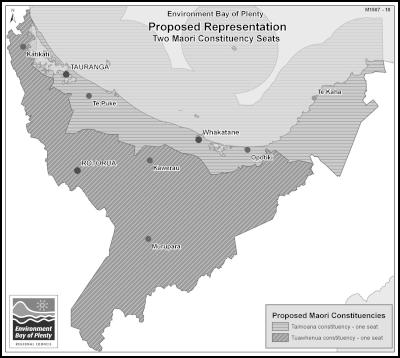Major electoral changes proposed for council
Major electoral changes proposed for regional council

Click to enlarge

Click to enlarge
MEDIA RELEASE
Major electoral changes proposed for
regional council
For immediate release: Tuesday 6 June 2006
Environment Bay of Plenty councillors want to cut back their numbers at the next election.
At an extraordinary meeting today (Tuesday 6 June), a majority of regional councillors supported a proposal to reduce the number around the council table from 14 to 10.
If it goes ahead, this would result in eight general seats and two dedicated Maori seats being vied for at the local body election in October 2007. At the moment, there are 11 general constituency and three Maori constituency representatives on the council.
The proposal will now be advertised for submissions. If submitters appeal the final proposal, it will go to the Local Government Commission, which has the final say.
Chairman John Cronin says the current number of councillors is too unwieldy. “There are simply too many of us for the size of our region’s population and the work that needs to be done,” he explains. “By cutting numbers, we think we will have more a much more efficient and effective team. In the end, it’s about good governance.”
Mr Cronin points out that other Bay of Plenty councils work well with smaller numbers.
At the last representation review in 2003, Environment Bay of Plenty proposed having 10 general seats and two Maori seats. The recommendation was overturned by the Local Government Commission, on the basis of population growth in the western Bay of Plenty. A special population-based calculation is used to make sure that people living in different parts of a region are represented equally.
However, because of population changes, the current set up no longer complies with this calculation. “It means some areas are over-represented and others are not getting a fair deal,” Mr Cronin points out. The Local Government Commission also re-worked the boundaries in a way that didn’t take account of local communities of interest. The new boundaries would rectify that situation. “We are using this as an opportunity to sort things out.”
New Constituencies
Under the proposed system, the region would split into three general constituencies instead of four. Two councillors would represent the Eastern Bay of Plenty and two the Rotorua area. The remaining four councillors would represent a combined Tauranga and western Bay of Plenty constituency.
The three Maori constituencies created for the last election would be re-shaped into two. One would run as a band along the coastal strip from the East Cape to Tauranga, including Matakana Island and parts of Tauranga Harbour. The other would encompass the Rotorua district and inland areas.
Maori Representation
Mr Cronin says the
reduction in Maori constituency seats would not change that
sector’s proportion of representation in the council forum.
“They would have two voices out of 10 instead of three out
of 14, so it’s still around 20%.”
“This affects all Maori who choose the Maori roll option, and therefore includes Maori people who are from areas other than the Bay of Plenty but who now choose to live here. So the decisive factor is where the Maori roll voters live now rather than their tribal linkages,” Mr Cronin notes.
Current System -
Proposed System -
General Constituencies Seats General
Constituency Seats
Rotorua 3 Rotorua 2
Eastern
Bay of Plenty 2 Eastern Bay of Plenty 2
Western Bay
of Plenty 2 Western Bay/Tauranga 4
Tauranga
4
Maori
Constituency Seats
Mauao 1 Tuawhenua 1
Okurei 1 Taimoana 1
Kohi 1
ENDS


 Gordon Campbell: On The Hikoi Aftermath
Gordon Campbell: On The Hikoi Aftermath Stats NZ: National Population Estimates: At 30 September 2024 (2018-base)
Stats NZ: National Population Estimates: At 30 September 2024 (2018-base) NZ Government: New Zealand’s COP29 National Statement
NZ Government: New Zealand’s COP29 National Statement Surf Life Saving NZ: Volunteer Lifeguards Make Big Effort To Keep Us Safe, As Paid Lifeguard Service Commences In Northern Region
Surf Life Saving NZ: Volunteer Lifeguards Make Big Effort To Keep Us Safe, As Paid Lifeguard Service Commences In Northern Region Action Station: Biggest Ever Community Petition, With Over 200,000 Signatures, Opposes Treaty Principles Bill
Action Station: Biggest Ever Community Petition, With Over 200,000 Signatures, Opposes Treaty Principles Bill Palestinians for Hīkoi mō te Tiriti: Statement From Palestinian Leaders - Hīkoi Mō Te Tiriti Is A Historic Moment For All In Aotearoa
Palestinians for Hīkoi mō te Tiriti: Statement From Palestinian Leaders - Hīkoi Mō Te Tiriti Is A Historic Moment For All In Aotearoa Anglican Church in Aotearoa: Anglican Archbishops To Join Hīkoi Mō Te Tiriti In Wellington
Anglican Church in Aotearoa: Anglican Archbishops To Join Hīkoi Mō Te Tiriti In Wellington


